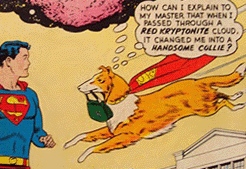For personal reasons, I decided to write a bit about dogs in superhero comics. The very brief history is, a long time ago there were a bunch of dogs in superhero comics. Then creators and publishers decided to put them outside, but dogs being clever creatures, they keep sneaking back into the house.
The most famous dog in superhero comics by far is Krypto. (If we open the field up to animation characters, Underdog might contend for pack leader.) DC Comics introduced Krypto in 1955. Thirty years later, they decided that Krypto was not grim, and neither was he gritty. DC was launching one of the first of their laborious attempts to “clean up” and modernize their continuity, which they believe should always be done in full view of readers, over months (lately, years) of time, across all their books at once, which may seem like it offers all the excitement of watching stage hands set up props between acts but which goes on for a lot longer.
So they allowed Alan Moore and Curt Swan to give him a hero’s death in what was a lovely, classic story. Comics being comics, Krypto stayed dead—worse than dead, nonexistent—for about two years. That Krypto was just a “pocket universe” Krypto, mind you. Not like having a real superpowered dog in your comic book at all. It’s like having a superpowered dog from a pocket universe in your comic book. Dogs named Krypto have cropped up in DC books and cartoons (warning: burst of music!) since then. “Superman’s superpet” is just too strong a concept, specifically a child-friendly concept, to stop making money.
Ace the Bathound is the second-most-famous canine sidekick in comics, but he’s a distant second. DC introduced him a few months after the introduced Krypto. What’s interesting about Ace is that, in the mid-1950s stories in which he was introduced, he’s the scariest-looking character in the book. Take a look at the cover of his first story. Even with the goofy mask, he has comething of the look of a real dog. Nevertheless, per Wikipedia, Ace “disappeared from the Batman comics after Julius Schwartz took over as editor in 1964, and made only very occasional comic book appearances in the years afterward.”
The other week I snuck in a picture of Gnort, the alien Green Lantern of canine mein. Keith Giffen, JM DeMatteis and Kevin Maguire played up the most comical dog tropes: fleas, fleeting attention span (there’s a lot of retriever in Gnort), bad breath.
A few years ago on the Mike Allred message board, Lee Allred offered a deeper list:
Robotman (not the Doom Patrol one) had a talking robot dog.
GA Green Lantern had Streak the Wonder Dog (Streak actually replaced Green Lantern as main character in his own book!)
Rex the Wonder Dog starred for years in 1950s DC Comics.
Quality’s Dollman had a dog named Elmo.
Quality’s Manhunter had a dog partner named Thor.
Gleason Pulications’ Nightro had a dog named Blackie.
MLJ (later Archie ) had a main character dog, RANG-A-TANG.
In the Silver Age SUPERBOY comics, teenaged Lex Luthor had a sort of anti-Krypto super dog with a black cape. And the Kryptonite Kid had a kryptonite dog.
Conspicuously absent are superpowered dogs from Marvel Comics. I can’t think of any. (Top Dog doesn’t count. Not really a superhero.) Lack of superpowered pets constituted a brand-differentiator for the company, just like their comparative lack of teenaged sidekicks. (If we need an entire separate post on the matter of Rick Jones, we can do that.) Conspicuously eschewing the sidekick trope (no matter the mammal) was a way Stan Lee and his successors assured anxious tween and teen readers that his company’s comics were more sophisticated fare than the ones put out by “Brand Ecch.” Anxious readers like, er, me. (If we need an entire separate post about how I feel for Marvel Zombie hype as a kid, we can do that too.) I see that, while Marvel doesn’t publish dog stories, they will happily dress your teacup pooch in licensed Marvel dog clothing. Even I, Mister “Superheroes are mainstream entertainment,” would have thought the intersection of hardcore Marvel fandom and teacup-dog enthusiasm was the empty set.
Anxiety aside, there’s one dog-based comic-book story I loved when it came out and plan to dig out of the longbox to reread sometime. In the mid-1980s, now-defunct Comico licensed Jonny Quest from Hanna-Barbera. Issue 11 was told from the POV of Jonny’s dog, Bandit. Bandit gets kidnapped by an illegal dogfighting ring. They don’t expect to turn the little fellow into a fighter: they use small dogs to “blood” the big ones, as easy kills to turn their prospects vicious. (As Frank Norris understood, most dogs will avoid fighting other dogs to the death.) I’m not spoiling the story when I note that Bandit turns the tables on his kidnappers and saves the day and the dogs. What makes the story work is the pitch-perfect voice of Bandit, as written by William Messner-Loebs, and the perfect cartooning of artist Joe Staton. I should spare a word for Rick Taylor’s colors too.










